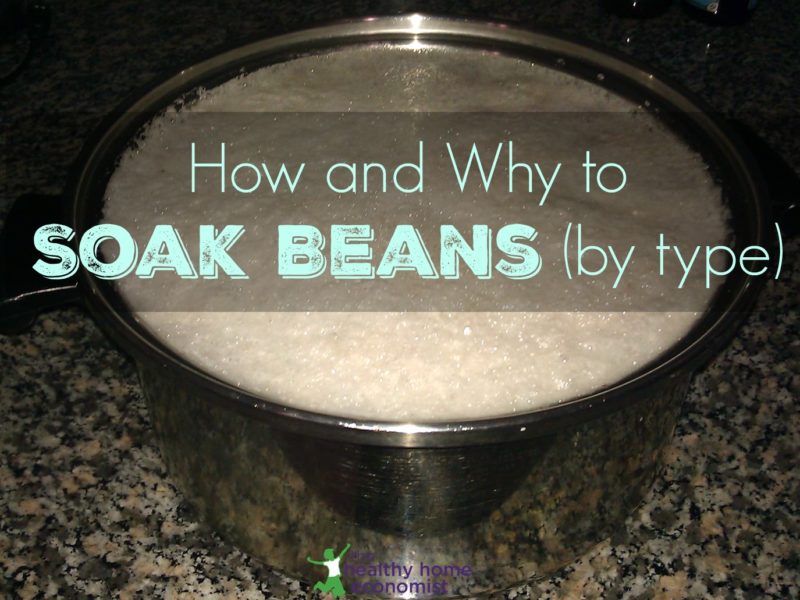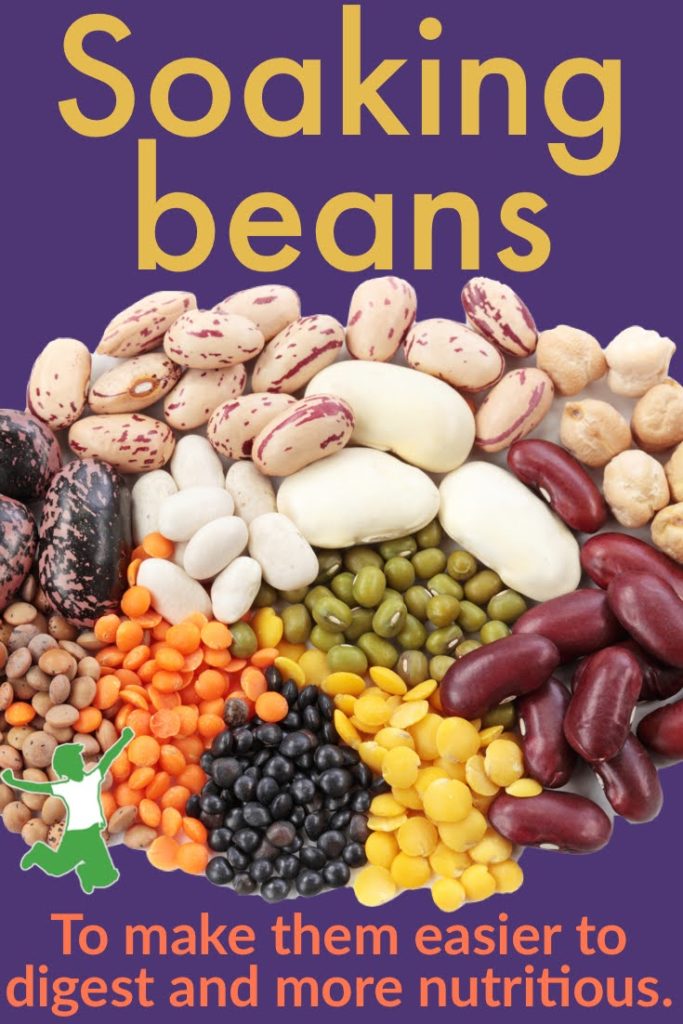Table of Contents[Hide][Show]
The simple overnight process of how to soak beans (by type) will help to eliminate gas and intestinal issues so you can enjoy eating these nutritious plant foods again!

I went on a bean soaking binge this past weekend, and the amount of scum that came to the top of the large pot of soaking kidney beans was so huge, I thought it deserved its own blog post. Soaking beans for many hours before cooking them produces a lot of scum which is course, is rinsed and drained away when the soaking is complete.
What is all that scum anyway? Anti-nutrients, that’s what! And those anti-nutrients such as phytic acid, lectins, and enzyme inhibitors are going to be in your gut causing you gas, heartburn, reflux, and whatever other digestive ills beset you when you eat something that isn’t particularly digestible unless you soak your beans before cooking them.
Traditional cultures took great care to prepare their legumes with a long soak before cooking to enhance digestibility and nutrient absorption.
I love Mexican food but really try to avoid Mexican restaurants for this reason .. they don’t soak their beans before cooking them!
After a meal at a Mexican restaurant, I will typically feel very bloated. Eating the same meal prepared at home where I soaked the beans properly before cooking results in no digestive upset whatsoever.
Take the Soaked Beans Challenge!
If you think unsoaked beans don’t cause you any trouble .. take this challenge. Soak beans next time before cooking and notice the difference in your stomach after eating.
You may think that the unsoaked beans don’t cause you any trouble, but you just may find that soaked beans are infinitely more filling and that you eat less and enjoy the meal more as a result!
Traditional peoples were very wise in the preparation of their foods. They not only selected nutritious foods but they prepared them for maximum digestibility and nutrition.
What good is eating nutritious legumes if the body is so whacked by the anti-nutrients that it can’t very easily extract and digest the nutrition?
So, the next time you make your beans, make sure you soak them first!
I soak large pots of various types of beans every month or so and then cook them – freezing for easy, quick meals when beans are required like homemade chili.
**If you absolutely do not have time to do this, at least buy pre-soaked legumes and beans packed in glass jars. Your digestion will thank you!
How To Prepare Beans by Soaking (video tutorial)
If you’ve never soaked beans before, it’s so easy. It’s a very similar process to soaking nuts. The method also mimics the wisdom of traditional societies that soaked seeds.
See this short video below that demonstrates the simple process.
Kidney shaped beans
For kidney shaped beans and dried/split peas, put a pinch of baking soda and enough water to cover in a large pot and soak uncovered for 12-24 hours. Drain, rinse and cook as usual.
Examples of kidney-shaped beans include:
- Red kidney beans
- White kidney beans (cannellini beans)
- Pinto beans
- Anasazi beans
- Black-eyed beans (black-eyed peas)
- Great Northern beans
- Lima beans
Non-kidney shaped beans (and other legumes)
For more oval-shaped beans and other legumes, soak for 12-24 hours in filtered water to cover plus 1 tablespoon of cider vinegar or lemon juice for every cup of dried beans/legumes used.
A homemade apple cider vinegar recipe or store-bought are both fine (make sure the ACV is packed in glass). Liquid whey from yogurt, kefir, or clabbered milk may also be used. Drain, rinse, and cook as usual.
Examples of non-kidney shaped beans include:
- Black beans (turtle beans)
- Navy beans
- Fava beans
- Adzuki beans
- Chickpeas
- Lentils
For maximum digestibility, it is best to rinse and refresh the filtered water and baking soda or the acidic medium once or twice during the soaking period. If you forget, no worries.
I try to always soak beans for the full 24 hours instead of just overnight. Sometimes if I get busy, I might even soak them 36 hours, but this is risky as they can get moldy sometimes if you go over 24 hours. Best to stay between 12-24 hours particularly during summer months.
How to Cook Beans After Soaking
After soaking, be sure to thoroughly drain and rinse the beans until all the scum is washed away. Then, complete the process by doing the following.
- Fill the pot of rinsed pre-soaked beans with fresh filtered water, bring to a boil, and skim away any additional foam that may come to the top at the start of the boil.
- Turn down the heat to a simmer, add 4 crushed garlic cloves, and cook until the beans are soft (about 4 hours).
- Drain beans and add to your favorite dish or let cool and freeze in large freezer bags for quick meals at a later date!
You won’t be needing over-the-counter gas meds after preparing beans the traditional way!
Should You Use the Soaking or Cooking Water?
Some alternative cooking circles advocate using the soaking or bean cooking water. Unfortunately, neither of these practices is traditional.
Using the cooked bean water or aquafaba is actually a dangerous practice. See the linked article for reasons to avoid this modern food especially during pregnancy!
Other Types of Legumes
This article plus video on soaking lentils provide additional information specifically for this legume. Because they are soaked exactly the same as all non-kidney shaped beans, it is helpful for visual learners.
Lentils were the favorite of nutritional pioneer Dr. Weston A. Price due to their very high potassium content.
Recipes Using Pre-soaked Beans and Legumes
Here are some recipes to try using soaked beans and other legumes to entice you!









You’re not quite correct.
The anti-nutrients (phytic acid, etc.) are broken down through the soaking process* (adding vinegar or soda helps depending on the bean). The scum is actually oligosaccharides and proteins, the former is helpful in the production of healthy gut bacteria– the byproduct of its metabolism is gas.
If you toss the scum, you will save yourself from flatulence, but the food will be less nutritious.
* Soaking tricks the beans into thinking they are ready to begin sprouting, in which case it activates enzymes to make resources bio-available to the growing sprout. The phytic acid is broken down by the enzyme phytase, from which denatured protein ‘scum’ remains– this is useful to us and easy to digest, there is no reason to throw it out.
I would love to read a source for this information, if you have one. Please and thanks!
Isn’t scum when soaking come from bacteria who digest the water + nutrient from bean and releasing CO2 that come out as scum? like what yeast do to dough. Just my assumption.
I thought I had read that beans shpuld be soaked even longer til they sprout. Well I soaked a big batch of chickpeas, in water only, changing the water and rinsing only once at night for 3 to 4 days. Every time I change the water the chickpeas smell really gross, I rinse them well and add new filtered water. Are they safe to cook or ready for the bin? I didnt know I needed a a soaking medium. My mom, in middle eastern cooking, always added a bit of baking soda to chickpeas only, not while soaking, but towards the very end of cooking time and it instantly softened them. Thoughts?
We like sprouted mung bean and often buy them from Asian Storse. I’ve heard that commercial mung bean sprouts often use chemical to help with growing and sterilization but I have not been able to find out any info online. Do you know if commercial mung bean sprouts are safe?
Thank you!
When I was kids, our biology teacher told us to put those mung bean above wet cotton
(analyzing photosynthesis process) and they grow so fast just need about 1 day, so I doubt they need any chemical for growing, but I don’t know and don’t realy care about sterilization process, since I always cooked them before I eat them.
I’ve always soaked my beans and added a little baking soda..but my daughter sais to use Apple Cidar Vinegar.. I love making beans this way instead of out of the jar just to warm up…These are so much better for you..
In 1947 edition of Let’s Cook It Right, nutritionist Adelle Davis says “Soda, which appears to harm a number of B vitamins, should not be used in cooking legumes.
In 1962 edition she says, “Soda, which destroys a number of the B vitamins, should not be used in cooking legumes.”